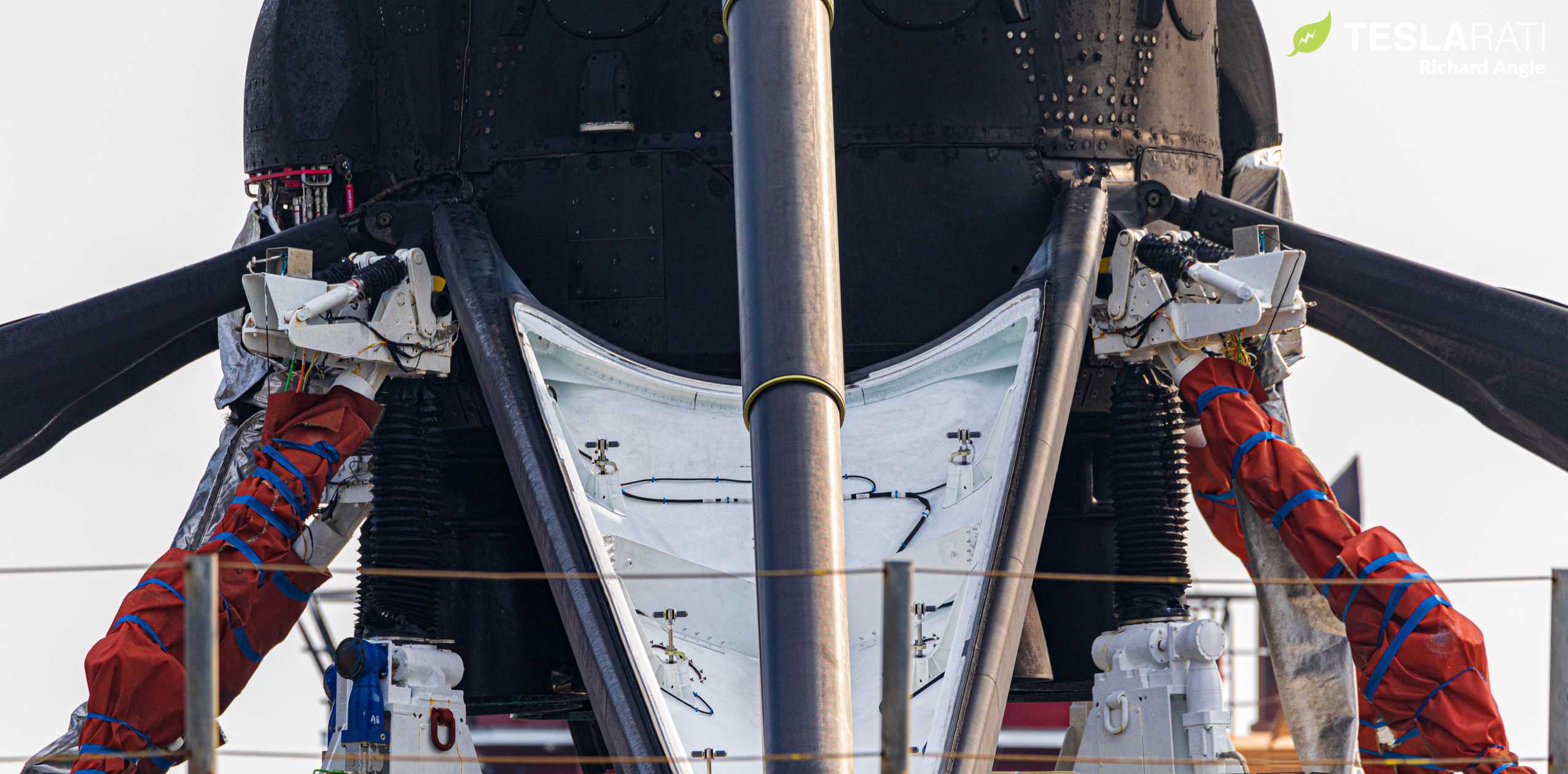

News
SpaceX retracts latest rocket’s landing legs in impressive feat of durability
A SpaceX Falcon 9 booster had all four of its landing legs successfully retracted after a flawless fourth launch and landing, highlighting the impressive margins and durability of the rocket’s upgraded Block 5 design.
On April 22nd, Falcon 9 booster B1051 lifted off on its fourth orbital-class mission – also its second 60-satellite Starlink launch this. Around eight minutes later, B1051 successfully landed aboard drone ship Of Course I Still Love You (OCISLY), ending a back-to-back streak of failed ocean recoveries for SpaceX and verifying that the cause of a March 2020 in-flight engine failure had been rectified. After the loss of booster B1056 and B1048 in February and March, it was also simply a relief to have B1051 safe and sound aboard OCISLY, ensuring that the rocket should be able to support another launch in the near future.
After sailing in port on April 26th, SpaceX technicians lifted a booster off of drone ship OCISLY’s deck for the first time since late January – coincidentally (or maybe not) also Falcon 9 B1051. Two days after its arrival in port and transfer onto dry land, SpaceX successfully retracted all of the massive booster’s landing legs in less than three hours and had it ready for transport less than two hours after that. While B1051’s brisk fourth recovery didn’t break any records, it still serves as a reminder of Falcon 9’s impressive durability in light of the landing it experienced just ~85 days prior.
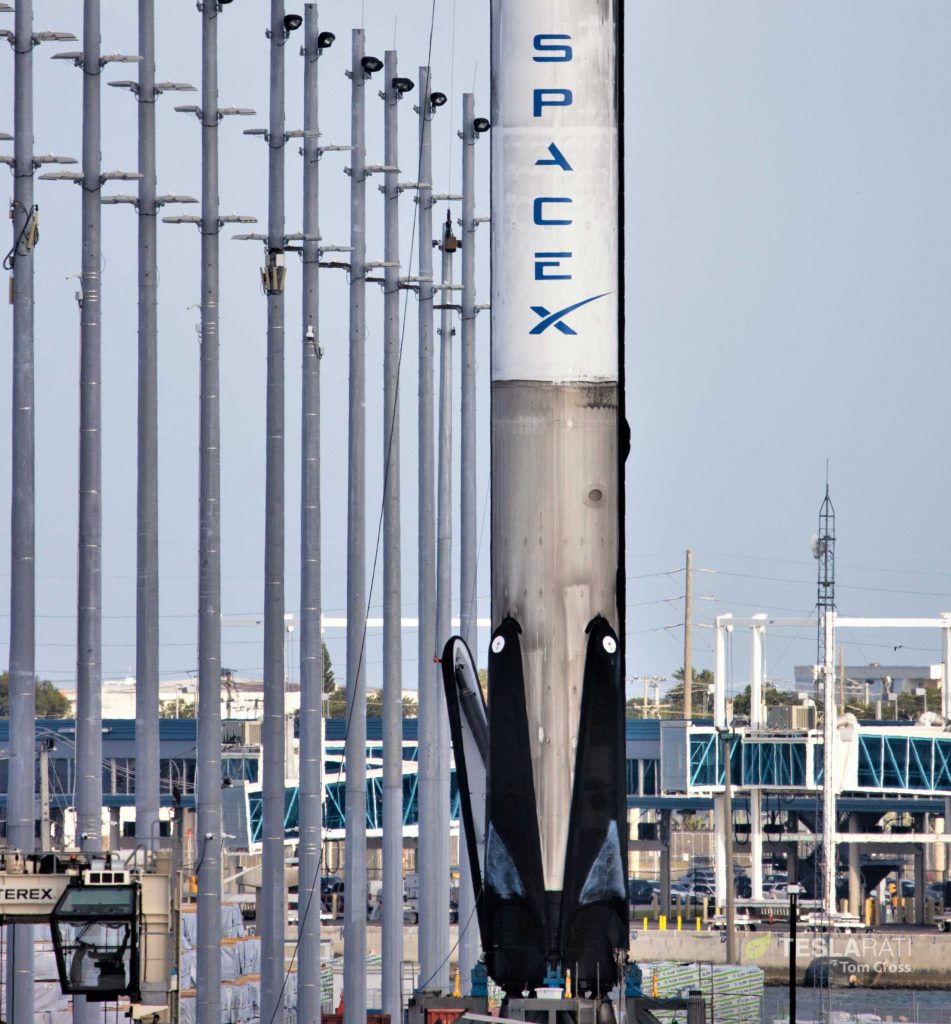
B1051’s successful leg retraction after its fourth launch and landing is particularly impressive for one main reason: after its third launch, the booster suffered perhaps the hardest drone ship landing any Block 5 rocket has thus far experienced.
Taken in March 2019 and February 2020 after Falcon 9 B1051’s first and third launches and landings, the photo below reveals just how hard a landing B1051 experienced after its Starlink-4 launch. Built almost entirely out of carbon fiber composites and mounted directly to the rocket’s tank walls, Falcon’s telescoping landing legs rely on something known as a ‘crush core’ – made out of aluminum honeycomb – that’s designed to intentionally collapse under a very specific amount of stress.
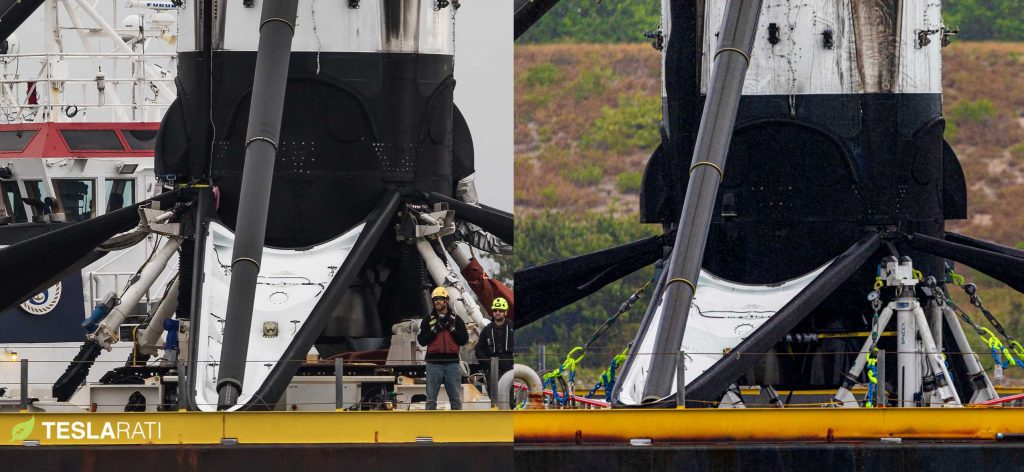
The crush core is situated in the very tip of the cylindrical leg booms and is easily visible above on the left, while it has nearly disappeared in the right (after) photo after an exceptionally hard landing used up what looks like 90+% of the booster’s safety margin. In other words, if B1051 had landed just a little harder after its third launch, it’s possible that the booster’s landing leg booms would have used up all their crush cores and been driven into the kerosene tank they attach to, potentially totaling the Falcon 9 first stage.
Instead, while clearly a rough landing, B1051 appears to have had its landing leg crush cores replaced and was made ready for another Starlink launch less than three months after that exceptionally hard landing. In other words, despite the rarity of similar hard landings over dozens of recent booster landings, SpaceX was apparently almost entirely unconcerned about the rocket’s state.
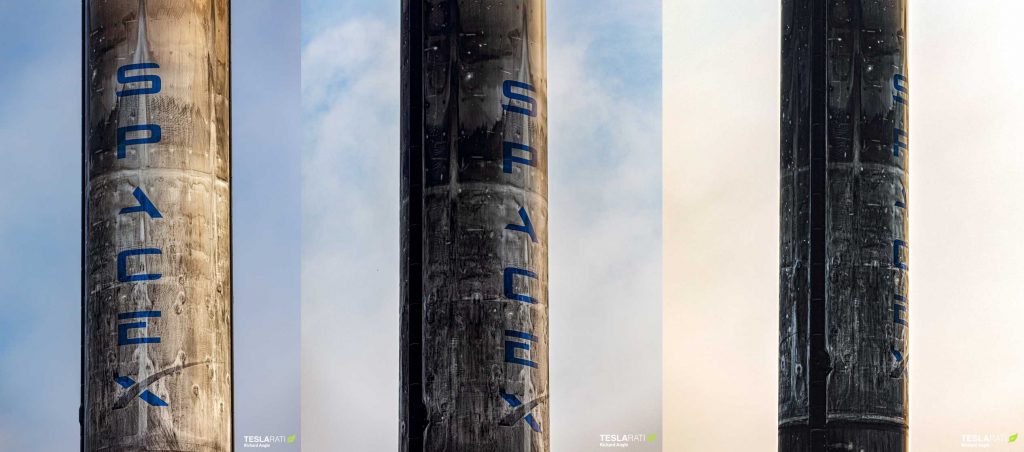
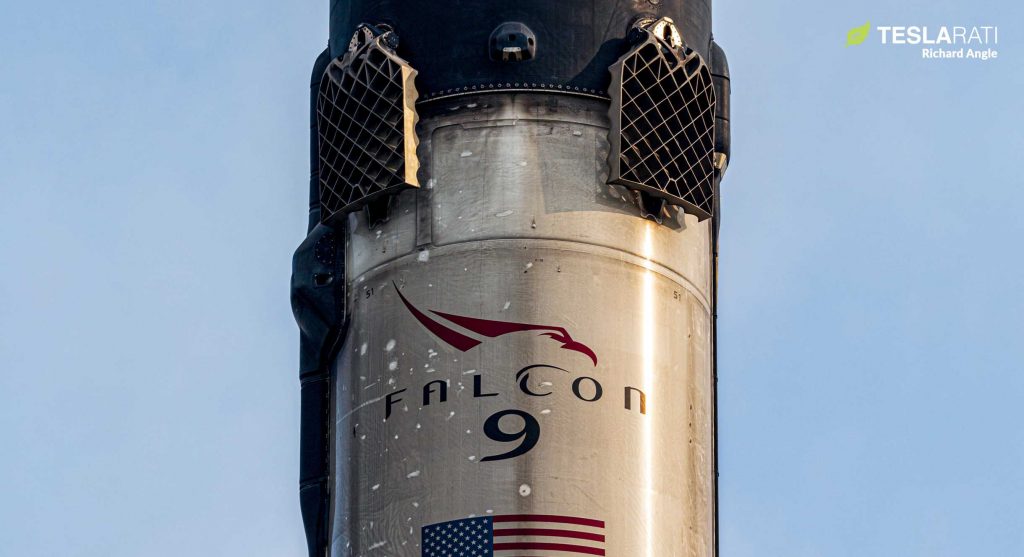
As usual, the company almost certainly checked the structural integrity of B1051’s major welds and landing leg hardware before certifying the vehicle for its fourth launch, but the fact that its reuse was so seemingly unexceptional is a testament to the sheer durability of SpaceX’s reusable rocket boosters. Thanks to the modularity of its design, B1051 should have no trouble performing at least several more orbital-class launches over the next several months (if not years). More likely than not, the Falcon 9 Block 5 rocket will fly again just two or so months from now on another Starlink mission, of which SpaceX has 20+ nominally scheduled this year alone.

Elon Musk
Tesla AI Head says future FSD feature has already partially shipped

Tesla’s Head of AI, Ashok Elluswamy, says that something that was expected with version 14.3 of the company’s Full Self-Driving platform has already partially shipped with the current build of version 14.2.
Tesla and CEO Elon Musk have teased on several occasions that reasoning will be a big piece of future Full Self-Driving builds, helping bring forth the “sentient” narrative that the company has pushed for these more advanced FSD versions.
Back in October on the Q3 Earnings Call, Musk said:
“With reasoning, it’s literally going to think about which parking spot to pick. It’ll drop you off at the entrance of the store, then go find a parking spot. It’s going to spot empty spots much better than a human. It’s going to use reasoning to solve things.”
Musk said in the same month:
“By v14.3, your car will feel like it is sentient.”
Amazingly, Tesla Full Self-Driving v14.2.2.2, which is the most recent iteration released, is very close to this sentient feeling. However, there are more things that need to be improved, and logic appears to be in the future plans to help with decision-making in general, alongside other refinements and features.
On Thursday evening, Elluswamy revealed that some of the reasoning features have already been rolled out, confirming that it has been added to navigation route changes during construction, as well as with parking options.
He added that “more and more reasoning will ship in Q1.”
🚨 Tesla’s Ashok Elluswamy reveals Nav decisions when encountering construction and parking options contain “some elements of reasoning”
More uses of reasoning will be shipped later this quarter, a big tidbit of info as we wait v14.3 https://t.co/jty8llgsKM
— TESLARATI (@Teslarati) January 9, 2026
Interestingly, parking improvements were hinted at being added in the initial rollout of v14.2 several months ago. These had not rolled out to vehicles quite yet, as they were listed under the future improvements portion of the release notes, but it appears things have already started to make their way to cars in a limited fashion.
Tesla Full Self-Driving v14.2 – Full Review, the Good and the Bad
As reasoning is more involved in more of the Full Self-Driving suite, it is likely we will see cars make better decisions in terms of routing and navigation, which is a big complaint of many owners (including me).
Additionally, the operation as a whole should be smoother and more comfortable to owners, which is hard to believe considering how good it is already. Nevertheless, there are absolutely improvements that need to be made before Tesla can introduce completely unsupervised FSD.
Elon Musk
Tesla’s Elon Musk: 10 billion miles needed for safe Unsupervised FSD
As per the CEO, roughly 10 billion miles of training data are required due to reality’s “super long tail of complexity.”

Tesla CEO Elon Musk has provided an updated estimate for the training data needed to achieve truly safe unsupervised Full Self-Driving (FSD).
As per the CEO, roughly 10 billion miles of training data are required due to reality’s “super long tail of complexity.”
10 billion miles of training data
Musk comment came as a reply to Apple and Rivian alum Paul Beisel, who posted an analysis on X about the gap between tech demonstrations and real-world products. In his post, Beisel highlighted Tesla’s data-driven lead in autonomy, and he also argued that it would not be easy for rivals to become a legitimate competitor to FSD quickly.
“The notion that someone can ‘catch up’ to this problem primarily through simulation and limited on-road exposure strikes me as deeply naive. This is not a demo problem. It is a scale, data, and iteration problem— and Tesla is already far, far down that road while others are just getting started,” Beisel wrote.
Musk responded to Beisel’s post, stating that “Roughly 10 billion miles of training data is needed to achieve safe unsupervised self-driving. Reality has a super long tail of complexity.” This is quite interesting considering that in his Master Plan Part Deux, Elon Musk estimated that worldwide regulatory approval for autonomous driving would require around 6 billion miles.
FSD’s total training miles
As 2025 came to a close, Tesla community members observed that FSD was already nearing 7 billion miles driven, with over 2.5 billion miles being from inner city roads. The 7-billion-mile mark was passed just a few days later. This suggests that Tesla is likely the company today with the most training data for its autonomous driving program.
The difficulties of achieving autonomy were referenced by Elon Musk recently, when he commented on Nvidia’s Alpamayo program. As per Musk, “they will find that it’s easy to get to 99% and then super hard to solve the long tail of the distribution.” These sentiments were echoed by Tesla VP for AI software Ashok Elluswamy, who also noted on X that “the long tail is sooo long, that most people can’t grasp it.”
News
Tesla earns top honors at MotorTrend’s SDV Innovator Awards
MotorTrend’s SDV Awards were presented during CES 2026 in Las Vegas.

Tesla emerged as one of the most recognized automakers at MotorTrend’s 2026 Software-Defined Vehicle (SDV) Innovator Awards.
As could be seen in a press release from the publication, two key Tesla employees were honored for their work on AI, autonomy, and vehicle software. MotorTrend’s SDV Awards were presented during CES 2026 in Las Vegas.
Tesla leaders and engineers recognized
The fourth annual SDV Innovator Awards celebrate pioneers and experts who are pushing the automotive industry deeper into software-driven development. Among the most notable honorees for this year was Ashok Elluswamy, Tesla’s Vice President of AI Software, who received a Pioneer Award for his role in advancing artificial intelligence and autonomy across the company’s vehicle lineup.
Tesla also secured recognition in the Expert category, with Lawson Fulton, a staff Autopilot machine learning engineer, honored for his contributions to Tesla’s driver-assistance and autonomous systems.
Tesla’s software-first strategy
While automakers like General Motors, Ford, and Rivian also received recognition, Tesla’s multiple awards stood out given the company’s outsized role in popularizing software-defined vehicles over the past decade. From frequent OTA updates to its data-driven approach to autonomy, Tesla has consistently treated vehicles as evolving software platforms rather than static products.
This has made Tesla’s vehicles very unique in their respective sectors, as they are arguably the only cars that objectively get better over time. This is especially true for vehicles that are loaded with the company’s Full Self-Driving system, which are getting progressively more intelligent and autonomous over time. The majority of Tesla’s updates to its vehicles are free as well, which is very much appreciated by customers worldwide.








